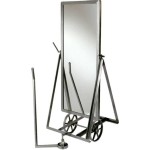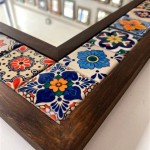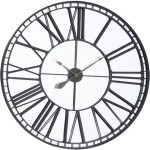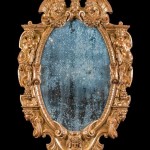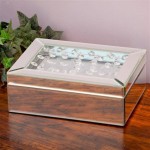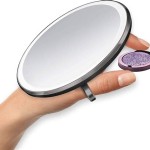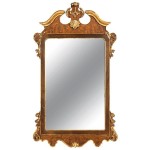How Much Is Antique Mirror Glass?
Determining the value of antique mirror glass is a complex process involving numerous factors. Unlike mass-produced modern mirrors, antique mirrors possess unique characteristics that influence their price, ranging from the type of glass used to its historical period and overall condition.
One of the primary factors affecting value is the age of the mirror. Generally, older mirrors command higher prices, especially those dating back to the 18th century or earlier. These early mirrors often utilized mercury silvering, a process discontinued due to its toxicity. The presence of mercury silvering, identifiable by a slightly mottled or foxed appearance, can significantly increase a mirror’s value.
The size and shape of the mirror also play a crucial role. Large antique mirrors are typically rarer and more desirable than smaller ones, particularly those with elaborate or unusual shapes. Overmantel mirrors, designed to be placed above fireplaces, are particularly sought after, especially those with ornate frames and beveled edges.
The condition of the mirror is another key factor. While minor imperfections, such as slight foxing or age-related wear, can be expected in antique mirrors and even enhance their charm, significant damage, like large cracks or extensive silvering loss, can greatly diminish their value. Restoration attempts can also affect the price, with professionally restored mirrors generally retaining more value than those with amateur repairs.
The type of glass used in the antique mirror further influences its worth. Early mirrors were made using hand-blown glass, which often contains imperfections like bubbles or ripples. These imperfections, considered a mark of authenticity and craftsmanship, can increase a mirror’s value among collectors. Later antique mirrors might utilize plate glass, a manufacturing process introduced in the 19th century, resulting in a smoother, more uniform surface.
The mirror's frame, while technically separate from the glass itself, significantly contributes to the overall value. Elaborately carved frames made from high-quality materials like mahogany or walnut can greatly enhance a mirror’s worth. The frame's style and condition also play a role, with original, undamaged frames adding more value than replacements or those requiring extensive restoration.
Provenance, or the documented history of ownership, can also significantly impact the value of an antique mirror. Mirrors with a known history, particularly those associated with prominent historical figures or events, can command significantly higher prices. Documented provenance provides authentication and adds a layer of historical significance to the piece.
Regional variations can also influence the price of antique mirrors. Certain styles and types of mirrors might be more prevalent or desirable in specific geographic areas, affecting their value in those markets. For instance, Venetian glass mirrors, renowned for their elaborate designs and craftsmanship, might command higher prices in areas with a strong interest in Italian antiques.
The current market trends and demand for specific styles of antique mirrors further contribute to price fluctuations. Certain periods or designs might experience periods of increased popularity, driving up their value. Keeping abreast of current antique market trends can provide insights into potential price ranges.
It’s important to consult reputable antique dealers and appraisers for a professional evaluation of an antique mirror's value. They possess the expertise to assess the various factors mentioned above and provide an accurate appraisal based on current market conditions. Online auction platforms and antique marketplaces can also offer insights into the prices realized for similar mirrors, but professional appraisal remains the most reliable method for determining accurate value.
Photographs of the mirror, including close-ups of the glass, frame, and any markings, can be beneficial when consulting with appraisers. Providing details about the mirror's dimensions, any known history, and its overall condition can assist in the appraisal process.
Understanding the multitude of factors contributing to an antique mirror’s value requires careful consideration and research. The combination of age, size, condition, glass type, frame, provenance, and market trends creates a unique valuation for each antique mirror, making it a fascinating and complex area of the antiques market.
Potential buyers should also be aware of reproductions and fakes in the antique mirror market. Careful examination and consultation with reputable experts are crucial to ensure authenticity before making a purchase. Looking for signs of age, consistent wear patterns, and the characteristics of the specific period are essential steps in avoiding counterfeit antique mirrors.
The value of antique mirror glass is not a fixed entity but rather a dynamic interplay of historical significance, material characteristics, and market forces. Through diligent research and professional consultation, individuals can gain a deeper understanding of the intricacies involved in determining the worth of these reflective pieces of history.

Antique Mirror Glass

Antique Mirror Glass Safety Replacements

Glass Distressed Mirror Antique Usage Home At Rs 180 In Mumbai

Sx 6040 Antique Mirror Decorative S Llc

Antique Mirror Glossy Glass Tile 12x24x13 64 Flooring Gray

Antique Mirror Color Copper Free Silver Glass Tiles China Mirrors Smoked Backsplash Wall Made In Com

Antique Mirror Glass Aged Distressed Foxed Tiles 40x40cm

New Design Antique Mirror Glass Wall Explore China Whole And Globalsources Com

Broe Vintage Antique Mirror Glass Distressed By Hand Black Frame

Antique Mirror Tiles Glass Backsplash

